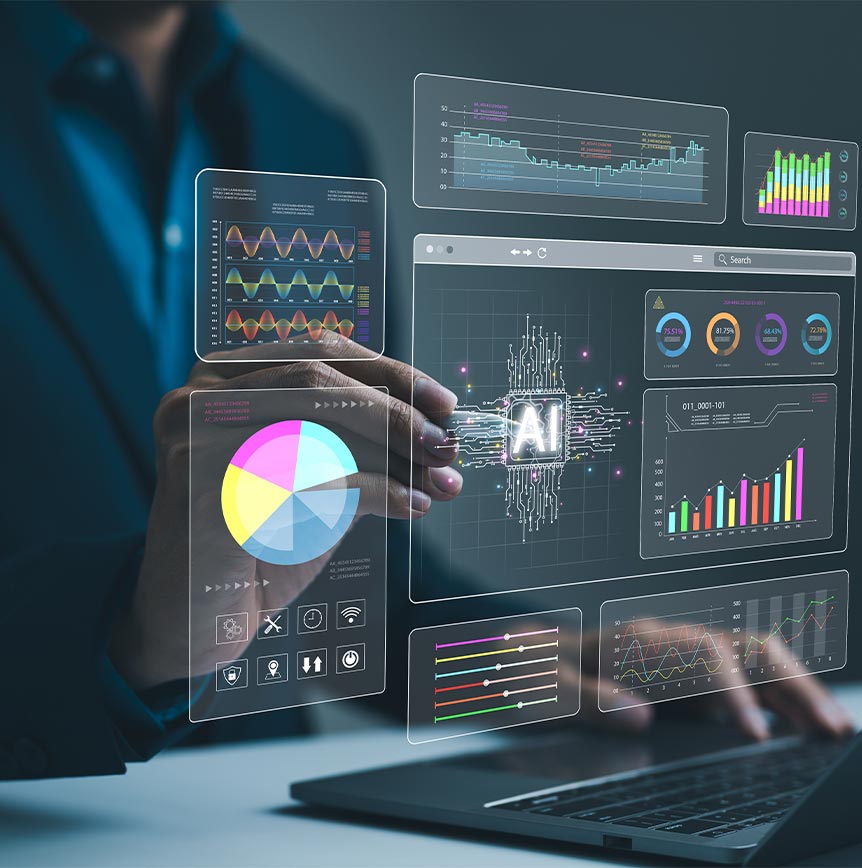When it comes to Generative AI (GenAI), there is no shortage of predictions and statistics to forecast its trajectory. So, here are a few to set the stage for this blog:
- Gartner: “By 2026, AI models from organizations that operationalize AI transparency, trust and security will achieve a 50% improvement in terms of adoption, business goals and user acceptance.”
- GenAI is predicted to unleash immense value – somewhere between $3.5 to $4 trillion.
- “By 2025, 750 million apps will be built using [language learning models] LLMs” that will automate 50% of the digital work processes. GenAI solutions will prove to be transformative in most business processes and across the value stream for governments and the private sector.
- Gartner predicts that by 2026, “More than 80% of enterprises will have used generative AI APIs or models, and/or deployed GenAI-enabled applications in production environments, up from less than 5% in 2023.”
The Transformative Power of GenAI in GovCon
There is no question that GenAI is emerging as a powerful technology that has the potential to transform industries, companies, business processes – and government agencies and their operations. GenAI’s transformative power lies in its capability to augment human cognitive abilities by automating tasks that were previously thought of as creative, complex knowledge-worker tasks. GenAI is even dubbed as the cognitive industrial revolution and described as “bigger than the internet.”
GenAI has undoubtedly spawned one of the most significant technological hype cycles in recent memory, with bold claims about its potential to revolutionize virtually every industry and profession, including the GovCon sector. While enthusiasm is warranted given the remarkable capabilities demonstrated by many solutions in content creation, data analysis and problem-solving, the reality is more nuanced than many headlines suggest.
GenAI Hype Cycle for Emerging Technologies
Gartner’s hype cycle for emerging technologies evaluates GenAI at the peak of inflated expectations, stating that there is a lot of hype where “every piece of software will have some kind of generative AI functionality in it, but the actual productivity gains from those features will take longer to be understood.”
Additionally, real-world implementation challenges around integration, customization, training, governance and measuring ROI have proven more complex than initial expectations suggested. That said, organizations that approach GenAI solutions with clear business objectives, thoughtful implementation strategies, and realistic expectations are indeed finding valuable applications that enhance productivity, unlock creativity and enable new capabilities. While Generative AI won’t magically transform businesses and government agencies overnight, this technology has crossed a threshold of practical utility that merits serious exploration. GenAI is already producing results and ROI in many vertical, horizontal and specialized use cases. It is imperative that organizations and government agencies experiment with selected use cases today to develop the organizational capabilities and understanding that will position them to extract meaningful value as these technologies continue to mature.
Utilizing High-Quality Data for Essential Healthcare Services
In a previous blog, “An Agile Methodology and a Roadmap to Deploy Responsible AI Products“, I discussed key criteria for successfully implementing GenAI projects. Most importantly, chosen use cases should drive business value by addressing a significant business challenge, and they must also leverage high-quality data to enhance the knowledge of LLMs.
Many federal agencies are sitting on treasure troves of unique and valuable data. If GenAI solutions are implemented securely, with the right guardrails, and with the highest data privacy standards, they can serve the public good and provide the government with substantial cost savings on operations.
One such example of a federal agency with valuable data is the Centers for Medicare & Medicaid Services (CMS). CMS oversees data on over 65 million Medicare beneficiaries, including medical records.
Medicare recipients face grave challenges that threaten both their financial well-being and access to essential healthcare services. Out-of-pocket costs are skyrocketing, leaving many seniors—especially those on fixed incomes—struggling to afford premiums, co-pays, deductibles and critical medications. Surprisingly, despite Medicare coverage, Medicare households spent an average of $7,000 on health care, accounting for 13.6% of their total household spending, forcing difficult decisions between essential heathcare services and basic necessities like food and housing.
Empowering Medicare Beneficiaries through CMS Blue Button
Beyond cost, Medicare’s complexity leaves millions vulnerable. Many beneficiaries find it overwhelming to choose the right plan; 69% of Medicare beneficiaries do not compare their own source of Medicare coverage with other Medicare options. , unexpected restrictions on provider access and inadequate coverage for critical treatments. Many also lack the tools or guidance to make informed decisions, leading to costly mistakes that could have long-lasting impacts on their health and finances. This widespread confusion is a ticking time bomb for the Medicare system, with millions of seniors needlessly suffering due to leading to a system that is burdened by .
CMS Blue Button, launched in 2010 and evolved into Blue Button 2.0 in 2018, is a data-sharing initiative that empowers Medicare beneficiaries to access and share their healthcare information through Fast Healthcare Interoperability Resources (FHIR)-based application programming interfaces (APIs). The platform manages petabytes of healthcare data for all 65 million Medicare beneficiaries, including up to four years of detailed Part A, B and D claims history; provider visits; medications; and healthcare costs. What began as simple, downloadable files has transformed into a comprehensive system that enables beneficiaries to better manage their health, improve care coordination, and make informed decisions by securely sharing their data with providers and third-party applications, ultimately promoting greater transparency and personalized care management across the healthcare ecosystem.
The integration of GenAI solutions with the CMS Blue Button 2.0 data presents an unprecedented opportunity to transform the Medicare enrollment process. By harnessing GenAI’s capability to analyze extensive datasets, CMS can develop a personalized recommendation engine that evaluates individual health requirements, preferences and financial constraints to guide beneficiaries toward optimal plan selections. It can process and analyze this complex dataset, enabling beneficiaries to make informed choices that better serve their unique circumstances, ultimately leading to improved health outcomes and financial stability, while also lowering healthcare costs for CMS.
Implementing GenAI solutions for Medicare data requires robust privacy frameworks beyond standard compliance. A responsible approach must incorporate multiple layers of protection: advanced data anonymization techniques that preserve analytical utility while eliminating re-identification risks; transparent AI governance that includes regular algorithm audits and bias detection protocols; and ethical review processes that evaluate potential unintended consequences before deployment. Specifically, this means establishing clear boundaries for how CMS Blue Button data interfaces with GenAI systems—ensuring beneficiary information remains protected while still enabling the personalized insights that drive better health decisions. Such safeguards aren’t merely regulatory requirements but essential components that build the trust necessary for widespread adoption among both healthcare providers and Medicare beneficiaries.
Facilitating Medicare Enrollment and Operational Improvement with GenAI
In addition, multi-modality features offered by GenAI can utilize voice, text and images to facilitate interactions with backend systems, driving operational improvement. These systems can instantly compare different Medicare options and provide the beneficiary with conversational AI interactions, which leads to informed decisions and improved outcomes for all.
Moreover, leveraging GenAI can significantly streamline the enrollment process, minimizing the administrative burdens that currently hinder beneficiary access to suitable plans. With AI-driven insights, CMS can proactively identify beneficiaries at risk of enrolling in suboptimal plans and engage them with tailored educational resources that clarify their options. Additionally, GenAI solutions can enhance ongoing plan evaluation by analyzing claims data to track the effectiveness of different plans in real time, allowing for timely adjustments and interventions. This data-driven approach not only empowers beneficiaries to navigate their options more effectively but also fosters a healthcare system that is responsive to the evolving needs of its senior population. By embracing GenAI, CMS has the potential to turn a critical challenge into a solution that ensures Medicare recipients receive the care and support they deserve.
Measuring the success of GenAI implementation requires a comprehensive evaluation framework that balances operational improvements with beneficiary outcomes. AI-powered process mining tools can establish precise pre-implementation baselines by analyzing existing workflow data across enrollment systems, call centers, and beneficiary touchpoints without disrupting operations. These systems can then continuously track the same metrics post-implementation, providing real-time visibility into efficiency gains while controlling for seasonal variations and other confounding factors.
Analyzing Healthcare ROI through Technology Enablement
From an ROI perspective, healthcare administrators should leverage predictive analytics and multi-variable attribution models that consider both immediate and long-term impacts. Initial measurement might utilize natural language processing to analyze call center transcripts and support tickets, quantifying reductions in common questions and enrollment confusion. Meanwhile, machine learning algorithms can begin tracking longitudinal data to connect plan selection with subsequent health outcomes. Rather than promising specific savings targets, AI-based scenario modeling can simulate potential outcomes based on early results, helping administrators understand when different types of returns should emerge across varied beneficiary segments.
For long-term evaluation, sophisticated cohort comparison algorithms can create matched beneficiary groups to isolate the specific impact of GenAI-powered recommendations on health outcomes, medication adherence and appropriate healthcare utilization. These AI systems can detect hidden patterns and unexpected benefits that wouldn’t be captured in traditional ROI frameworks. This technology enablement measurement approach transforms ROI assessment from a periodic financial calculation into a continuous learning system that helps healthcare administrators understand how GenAI investments create value across multiple dimensions of their mission and operations.
Transforming CMS Healthcare with GenAI Solutions at RELI Group
Despite the hype around GenAI solutions, its potential transformative power cannot be ignored. It’s a powerful technology that can help government agencies like CMS improve efficiency, reduce costs and enhance the delivery of Medicare and Medicaid Services. By leveraging AI-driven insights, CMS can simplify Medicare enrollment, provide personalized plan recommendations, and improve healthcare outcomes while optimizing spending. However, successful implementation requires more than just technology enablement; it demands a thoughtful approach and a structured methodology to security, privacy and governance.
At RELI Group, we’ve developed a proven GenAI methodology that takes AI projects from concept to deployment, ensuring successful, responsible and effective deployments. Now is the time to explore how GenAI solutions can create real impact—let’s transform healthcare delivery together.




